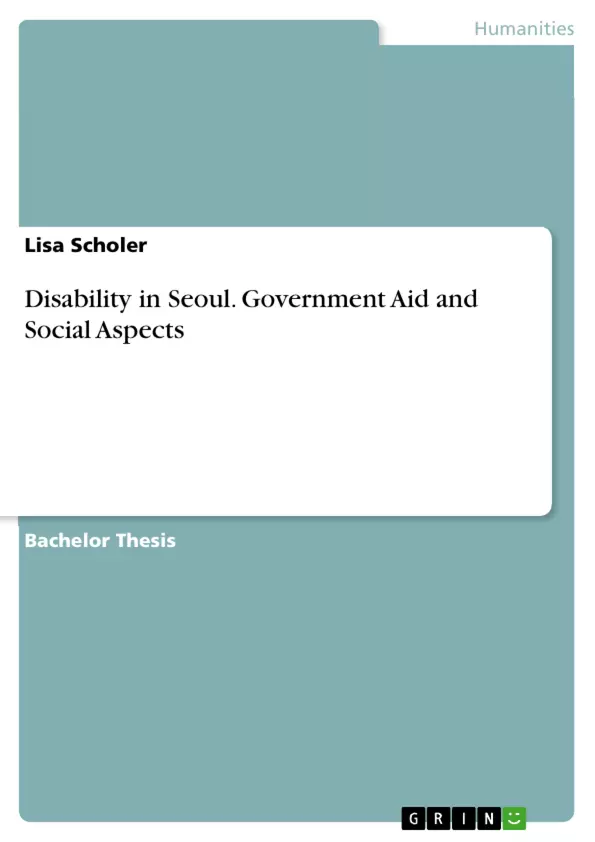In this paper we will start analyzing Seoul’s disability friendliness and accessibility with government aid and externally visible support slowly moving to the more invisible factors such as culture and the viewpoints of non-disabled citizens.
The following disorders are all categorised as disabilities regardless of whether they are temporary or permanent: vision impairment, deafness or partial deafness, mental health conditions, intellectual disability, acquired brain injury, autism spectrum disorder, physical disability, as well as, epileptic disorder, facial disability. However, due to the limitations of this paper, mainly aspects concerning wheelchair users and blind people will be discussed. Other invisible disabilities like deafness, muteness, autism, ADHD or mental health illnesses will not be covered in this paper because these disabilities or mental health issues are not perceivable by outsiders at first glance and require the analysis of specific aspects, such as, for example, the education of affected children, discrimination, judgmental conceptions of parents or legal guardian as well as other social factors and specific intricacies.
Currently, 2.6 million South Korean citizens are registered as having one or multiple disabilities, which amounts to 5% of the total South Korean population of approximately 51,368,000 people.
The number of disabled people doubled over a span of 10 years, whereas the total population only increased by approximately 5%. In 2020 also around 5% of the South Korean population were registered as having a disability, which amounts to 2,526,201 people. Therefore, it is interesting to analyze which steps have been taken to help the growing number of disabled people with the challenges that they face in their everyday lives.
When strolling in Seoul, people with disability are rarely seen, considering that 5% of the population is disabled. This phenomenon raises the question whether and how far disability-friendly Seoul actually is and whether there are some underlying problems invisible at first sight. It is important to keep in mind that disability-friendliness isn’t only represented by the governmentally and privately given facilities but also by the support or lack thereof of non-disabled citizens. The opinion of the affected minority group is essential in finding out whether the given support is sufficient, lacking or faulty since outsiders might not have the much-needed insight.
Inhaltsverzeichnis (Table of Contents)
- Introduction
- Governmental aid for disabled people in general
- Facilities for blind and visually impaired people and their struggles
- Facilities for wheelchair-users and their struggles
- Protests for wheelchair-accessible public transport
- Korean societal view on disability
- Religious aspects
- The need to cure disability
- Collectivism and Individualism
- Other social aspects and disadvantages
- Conclusion
Zielsetzung und Themenschwerpunkte (Objectives and Key Themes)
This paper aims to investigate the level of disability-friendliness in Seoul, examining both government aid and societal attitudes towards disability. The paper focuses on the experiences of wheelchair users and blind people, highlighting the challenges they face in navigating a city that is often perceived as inaccessible.
- Governmental aid and support for disabled people
- Accessibility of public spaces and transportation for people with disabilities
- Societal perceptions and attitudes towards disability in South Korea
- The impact of cultural factors on the inclusion of disabled people
- The need for further improvement in government support and social inclusion for disabled people
Zusammenfassung der Kapitel (Chapter Summaries)
- Introduction: This chapter provides an overview of the growing number of people with disabilities in South Korea, emphasizing the need for analysis of the challenges they face and the support provided. It also introduces the concept of disability-friendliness, highlighting the importance of considering both government initiatives and societal attitudes.
- Governmental aid for disabled people in general: This chapter explores the government's efforts to address the financial and social inequalities faced by disabled people in South Korea. It focuses on the Employment Promotion Law for Persons with Disabilities and the legal process of registering a disability.
- Facilities for blind and visually impaired people and their struggles: This chapter examines the accessibility of Seoul for blind and visually impaired people, focusing on the effectiveness of existing facilities like crosswalks, guide stripes, and elevators. It also explores potential limitations and challenges experienced by this group.
- Facilities for wheelchair-users and their struggles: This chapter analyzes the accessibility of public transportation and other public spaces in Seoul for wheelchair users. It delves into the effectiveness of existing facilities and identifies potential areas for improvement.
- Protests for wheelchair-accessible public transport: This chapter investigates recent protests demanding better access to public transportation for wheelchair users. It explores the specific grievances of the protesters and their demands for improved infrastructure and policy changes.
Schlüsselwörter (Keywords)
This paper explores the key concepts of disability, accessibility, government aid, societal inclusion, and cultural perceptions, focusing on the experiences of blind people and wheelchair users in Seoul. It examines the impact of government initiatives and social attitudes on the lives of people with disabilities in South Korea.
- Quote paper
- Lisa Scholer (Author), 2022, Disability in Seoul. Government Aid and Social Aspects, Munich, GRIN Verlag, https://www.grin.com/document/1355952



